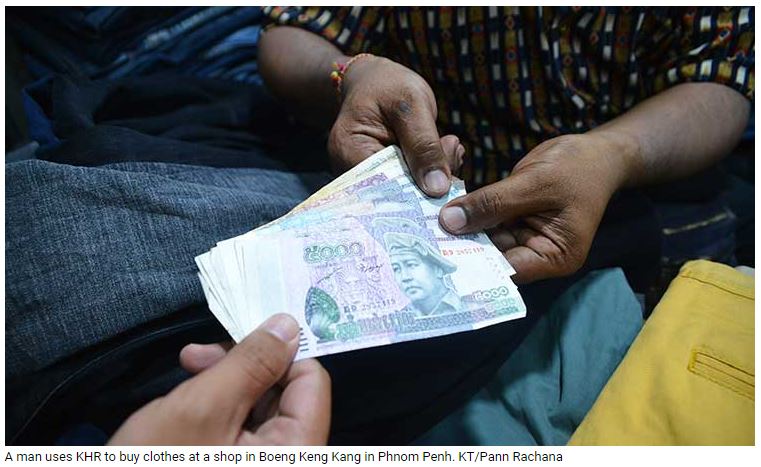Cambodia: NBC efforts to de-dollarize economy making progress
The National Bank of Cambodia (NBC) has been making serious efforts over the past several years to bring down the level of dollarization in the economy by promoting the use of local currency riel (KHR).
According to the Financial Stability Review 2021 of the central bank, the level of dollarization in the country still ruled over 80 percent. This level of dollarisation limits the NBC’s role in influencing money supply and interest rates in the country, the report said.
“A more riel-based economy will allow the NBC to effectively implement the monetary policy in response to economic shocks. Therefore, NBC has put efforts into gradually de-dollarizing the economy through the facilitation of the KHR usage, bringing regulations that aim to boost loans in KHR and by raising public awareness on the role of the national currency in strengthening economic resilience,” the report said.
“These efforts have contributed to gradually decreasing financial dollarization measured by the ratio of foreign currency deposits to total deposits,” the report added.
While banks’ local currency lending stayed above NBC’s required threshold of 10 percent, most lending continued to be in US dollars. A currency-wise breakdown of gross loans indicates that almost 88.6 percent of overall lending in 2021 was in USD, with the share of KHR loans standing at around 11.4 percent.
This shift towards using the riel line of credit has been duly supported by NBC in terms of riel liquidity provision through its Liquidity-Providing Collateralized Operations (LPCO) since 2016.
Similarly, the bulk of the deposits with banks also remained in USD, accounting for 91.4 percent of total deposits in 2021. The share of riel deposits, however, rose from 6.1 percent in 2018 to around nine percent in 2021.
NBC’s policy requiring banks to lend at least 10 percent of their credit in KHR has encouraged banks to raise more local currency deposits, the size of local currency loans of KHR 18.3 trillion still remained higher than the local currency deposits of KHR 13.7 trillion the banks managed to collect in 2021, necessitating continued injection of riel liquidity by NBC through its LPCO arrangement, the report said.
How the dollar came to position itself as a currency in Cambodia involved a slow process, and so, de-dollarizing fully might be an even slower process. To understand what form further de-dollarisation might take in Cambodia, it’s worth taking a look back at how the whole process started in the country.
Across the world, the dollar established its strength predominantly in the period following the Bretton Woods Agreement in 1944 following the Second World War when 44 countries agreed to peg their currencies to the dollar, and the dollar, in turn, was pegged to the price of gold.
The dominance of the dollar has meant that gold, oil and most other commodities have been since quoted in dollars and it has been the most sought-after currency by central banks to be kept as reserves. Moreover, massive amounts of transactions, investments, and funding are also now made in dollars.
The Bretton Woods Agreement with its pegging of other currencies to the dollar, and of the dollar to gold, gave USD the stability that made it the perfect candidate as a second currency in several countries troubled by unstable local currencies. In the case of Cambodia, there was no currency at all after the Khmer Rouge banned the use of money and bombed the headquarters of the NBC to the ground.
People had been forced to barter using rice and gold in order to conduct transactions. The riel was re-introduced in 1980 but the country received a massive economic shock when it was flooded with dollars in 1991-1992 when the United Nations Transitional Authority in Cambodia (UNTAC) started the work to bring back civilian rule in Cambodia.
With this influx of dollars, estimated to be $1.7 billion, from the UNTAC mission, the already weak riel depreciated, plummeting against the value of the dollar, and had to spend the subsequent years recovering before finally reaching the stability it has against the dollar today.
However, Cambodia’s relationship with the dollar has had both pros and cons over the years, and the mere fact of it being presented alongside the riel in the country means it served as a benchmark for the value of the riel as a study conducted by Jstage, a Japanese electronic journal platform for science and technology, revealed.
“High dollarisation may have also helped to stabilize price and purchasing power in the domestic economy,” the study report said. This stability helped the national currency only ever fluctuate slightly from the 4,000 riel per dollar for the most part of the past two decades.
But the riel has been a source of national pride and a symbol of Cambodia’s growth and establishment of independence and indications are that NBC’s efforts to de-dollarize the economy are bringing positive results – slowly but steadily.
Source: https://www.khmertimeskh.com/501188879/nbc-efforts-to-de-dollarize-economy-making-progress-2/


 Thailand
Thailand




